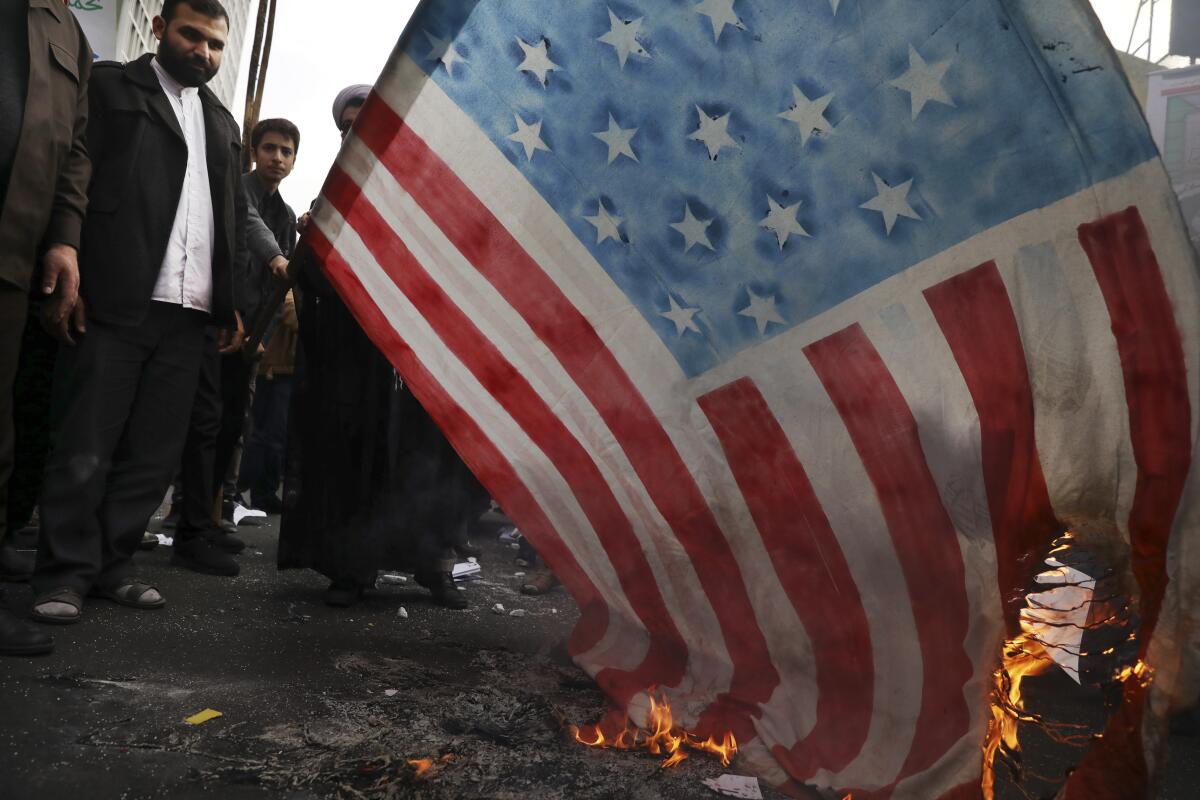Iran backs further away from nuclear deal on anniversary of embassy hostage crisis

- Share via
TEHRAN — Iran on Monday broke further away from its collapsing 2015 nuclear deal with world powers by announcing it’s doubling the number of advanced centrifuges it operates, calling the decision a direct result of President Trump’s withdrawal from the agreement.
The announcement — which also included Iran saying it now has a prototype centrifuge that works 50 times faster than those allowed under the deal — came as demonstrators across the country marked the 40th anniversary of the 1979 U.S. Embassy takeover that started a 444-day hostage crisis.
By starting up these advanced centrifuges, Iran further cuts into the one year that experts estimate Tehran would need to have enough material for building a nuclear weapon — if it chose to pursue one. Iran long has insisted its program is for peaceful purposes, though Western fears about its work led to the 2015 agreement that saw Tehran limit its enrichment of uranium in exchange for the lifting of economic sanctions.
Tehran has gone from producing about one pound of low-enriched uranium a day to 11 pounds, said Ali Akbar Salehi, the head of the Atomic Energy Organization of Iran.
Salehi dramatically pushed a button on a keyboard to start a chain of 30 IR-6 centrifuges at Iran’s Natanz nuclear facility, where he was being filmed, increasing the number of working centrifuges to 60.
“With the grace of God, I start the gas injection,” the U.S.-trained scientist said.
The nuclear deal limited Iran to using only 5,060 first-generation IR-1 centrifuges to enrich uranium by rapidly spinning uranium hexafluoride gas. Salehi also announced that scientists were working on a prototype he called the IR-9, which worked 50 times faster than the IR-1.
As of now, Iran is enriching uranium to 4.5%, in violation of the accord’s limit of 3.67%. Enriched uranium at the 3.67% level is enough for peaceful pursuits but is far below weapons-grade levels of 90%. At the 4.5% level, it is enough to help power Iran’s Bushehr reactor, the country’s only nuclear power plant.
Iranian President Hassan Rouhani will announce further steps away from the accord sometime soon, government spokesman Ali Rabiei separately said Monday, suggesting Salehi’s comments could be followed by additional violations of the nuclear deal. An announcement had been expected this week.
Iran has threatened in the past to push enrichment back up to 20%. That would worry nuclear nonproliferation experts because 20% is a short technical step away from reaching weapons-grade levels of 90%. It also has said it could ban inspectors from the United Nations nuclear watchdog, the International Atomic Energy Agency.
The Vienna-based IAEA did not immediately respond to a request for comment Monday on Iran’s announcement.
Iran broke through its stockpile and enrichment limitations to try to pressure Europe to offer it a new deal, more than a year since Trump unilaterally withdrew America from the accord. But so far, European nations have been unable to offer Iran a way to help it sell its oil abroad as it faces strict U.S. sanctions.
Meanwhile Monday, demonstrators gathered in front of the former U.S. Embassy in downtown Tehran as state television aired footage from other cities across the country marking the anniversary.
“Thanks to God, today the revolution’s seedlings have evolved into a fruitful and huge tree that its shadow has covered the entire” Middle East, said Gen. Abdolrahim Mousavi, the commander of the Iranian army.
However, this year’s commemoration of the embassy seizure comes as Iran’s regional allies in Iraq and Lebanon face widespread protests. The Iranian Consulate in Karbala, a holy city for Shiites, saw a mob attack it overnight. Three protesters were killed during the attack and 19 were wounded, along with seven policemen, Iraqi officials said.
Trump retweeted posts by Saudi-linked media showing the chaos outside the consulate. The violence comes after the hard-line Keyhan newspaper in Iran reiterated a call for demonstrators to seize U.S. and Saudi diplomatic posts in Iraq in response to the unrest.
The collapse of the nuclear deal coincided with a tense summer of mysterious attacks on oil tankers and Saudi oil facilities that the U.S. blamed on Iran. Tehran denied the allegation, though it did seize oil tankers and shoot down a U.S. military surveillance drone.
The U.S. has increased its military presence across the Mideast, including basing troops in Saudi Arabia for the first time since the aftermath of the Sept. 11, 2001, terror attacks. Both Saudi Arabia and the neighboring United Arab Emirates are believed to be talking to Tehran through back channels to ease tensions.
More to Read
Sign up for Essential California
The most important California stories and recommendations in your inbox every morning.
You may occasionally receive promotional content from the Los Angeles Times.










